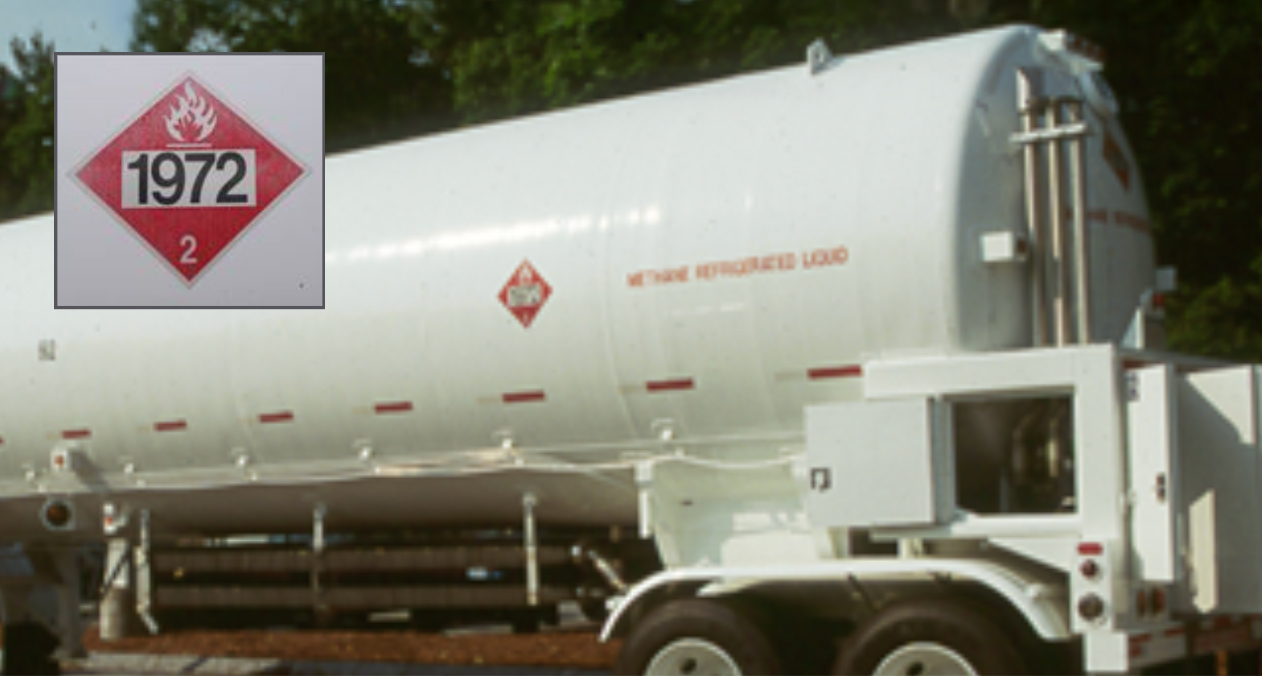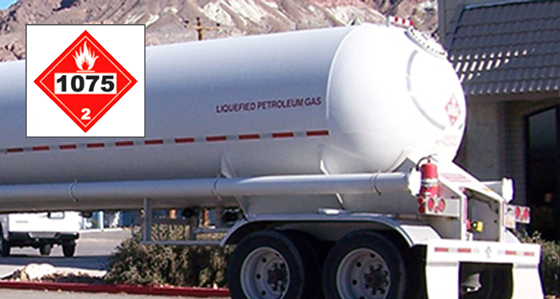 |
| LNG and LPG transport trailer incidents: Critical distinctions |
| Liquefied natural gas (LNG) transport trailers carry methane gas in a liquid state over roadways throughout the Northeast. LNG trailers may appear similar to those carrying liquefied petroleum gas (LPG, also known as propane). Learn to distinguish LNG and LPG trailers and the appropriate tactics for incidents involving these vehicles. |
|
| Trailer identification |
| LNG transport trailers carry LNG in insulated, double‑walled tanks at extremely cold temperatures (‑260°F) under very low pressure. LPG is transported in single‑walled tanks at ambient temperatures under high pressure. |
| You can easily distinguish LNG and LPG trailers by their placards, located on two sides and two ends of the tank: UN 1972 for LNG, and UN 1075 for LPG. Several additional distinctions can help you identify LNG and LPG trailers from a distance: |
 |
| LNG transport trailer |
 |
| • |
 | About 13 feet high and 40 to 45 feet long |
|
| • |
 |
Bucket box at rear of tank with valves, gauges and piping |
|
| • |
 |
Coils along tank belly |
|
| • |
 |
Flat ends |
|
|
|
 |
|
 |
 |
| LPG transport trailer |
 |
| • |
 | About 8 to 10 feet high and 20 to 30 feet long |
|
| • |
 |
No bucket box |
|
| • |
 |
No coils or external piping |
|
| • |
 |
Rounded ends |
|
|
|
 |
|
| |
| Leak and spill behavior |
| Small LNG and LPG leaks can occur at any time and may happen during routine trailer maintenance. Small leaks will appear as vapor escaping from flanges or relief valves. |
| Large LNG or LPG trailer spills result from a major failure of a tank. LNG and LPG spills behave differently: |
| LNG spills |
 |
LPG spills |
| LNG spills will appear as liquid drops that fall, form a puddle or pool, and flow along the ground. Spilled LNG vaporizes rapidly, creating a visible cloud as the LNG warms. This cloud is lighter than air and can spread over large areas. LNG vapor is flammable between 5 and 15 percent gas in air, but usually disperses before it can reach flammable concentrations. LNG that is released on or near water may vaporize rapidly and explosively. |
LPG spills generally do not form pools of liquid. Spilled LPG immediately forms a dense vapor cloud that can pool in confined spaces. Vaporized LPG is heavier than air and will sink into low‑lying areas. LPG vapor has a flammable range of 2 to 9.5 percent gas in air and requires careful monitoring to prevent hazardous accumulation. LPG does not react violently with water. |
|
|
 |
| Scene safety |
| In the event of a leak or spill from an LNG or LPG trailer, your priorities will be to protect public safety by containing the spill and controlling the vapor cloud. Follow these precautions for both LNG and LPG: |
| 1. |
 |
Park at least 300 feet away from any spill or vapor cloud. |
|
| 2. |
 |
Consult Guide 115 in the DOT Emergency Response Guidebook for appropriate evacuation distances and actions. |
|
| 3. |
 |
Eliminate potential ignition sources; use intrinsically safe equipment. |
|
| 4. |
 |
If you must approach the incident, do so with the minimum amount of personnel, each wearing PPE and SCBA. |
|
| 5. |
 |
Use CGIs at various heights to determine the location and movement of vapors, assess for potentially flammable concentrations and establish operating zones. Monitor continuously, as conditions can change rapidly. |
|
| 6. |
 |
Never enter the vapor cloud. Both LNG and LPG vapors may cause dizziness or asphyxiation without warning, especially in closed or confined areas. |
|
| 7. |
 |
Use a fog stream to disperse the vapor cloud and direct it away from nearby buildings and ignition sources. Ensure water does not contact pressure relief devices. |
|
| 8. |
 |
Use cloth barriers and absorbent materials to prevent spilled fuels from entering nearby sewers and storm drains. (This step should be taken whether or not a spill has occurred, especially if a trailer has overturned.) |
|
| 9. |
 |
Do not contact LNG or LPG. Contacting LNG, its vapor cloud or even surfaces that LNG has cooled can cause burns, severe injury and/or frostbite and can shatter gloves, boots and helmets. LPG is not cryogenic, but can cause eye and skin irritation with direct contact. |
|
| Mitigating vapor‑related dangers |
| LNG vapors |
 |
LPG vapors |
| • |
 |
Use hose lines on the vapor, not on the liquid, or the rate of vaporization will increase. |
| • |
 |
Never apply water directly to a pooled LNG spill, and do not allow the runoff from hose streams to mix with LNG. |
| • |
 |
High‑expansion (high‑ex) foam can be used on pooled LNG to create a frozen layer and minimize vapors. (High‑ex foam is primarily air, while other foams are largely water and will increase vaporization.) |
|
| • |
 |
Actively manage areas where LPG vapors could accumulate to hazardous concentrations, especially in low‑lying areas and confined spaces. |
| • |
 |
Use water spray to reduce LPG vapor concentration, prevent spreading and direct a vapor cloud away from ignition sources. |
|
|
|
 |
| Fire response |
| LNG fires |
 |
LPG fires |
| • |
 |
Allow the fire to burn while protecting nearby exposures. The fire will consume the available fuel as vaporization occurs. |
| • |
 |
Do NOT use water on an LNG fire unless you are specifically directed to do so by a technical advisor. Applying water to an LNG tank will cause it to heat up, resulting in the rapid vaporization of the LNG inside and an increase in internal pressure. Additionally, water that contacts LNG relief valves can cause icing, which may interfere with pressure release. |
| • |
 |
If you must reduce the flame volume, consider using high‑ex foam. Once flame volume is reduced, you may use dry chemical agents such as Purple‑K or Plus‑Fifty. Remain alert for possible re‑ignition. |
|
| • |
 |
Cool the LPG tank with water until well after the fire is out to prevent overheating and potential tank rupture. |
| • |
 |
Avoid spraying LPG pressure-relief devices. |
| • |
 |
Ensure all personnel maintain a safe distance to avoid hazards from steam and hot surfaces. |
|
|
|
 |
| Keep yourself, your team and the public safe this summer and year‑round. Visit firstresponder.ngridsafety.com today to register and complete your FREE utility safety training. |